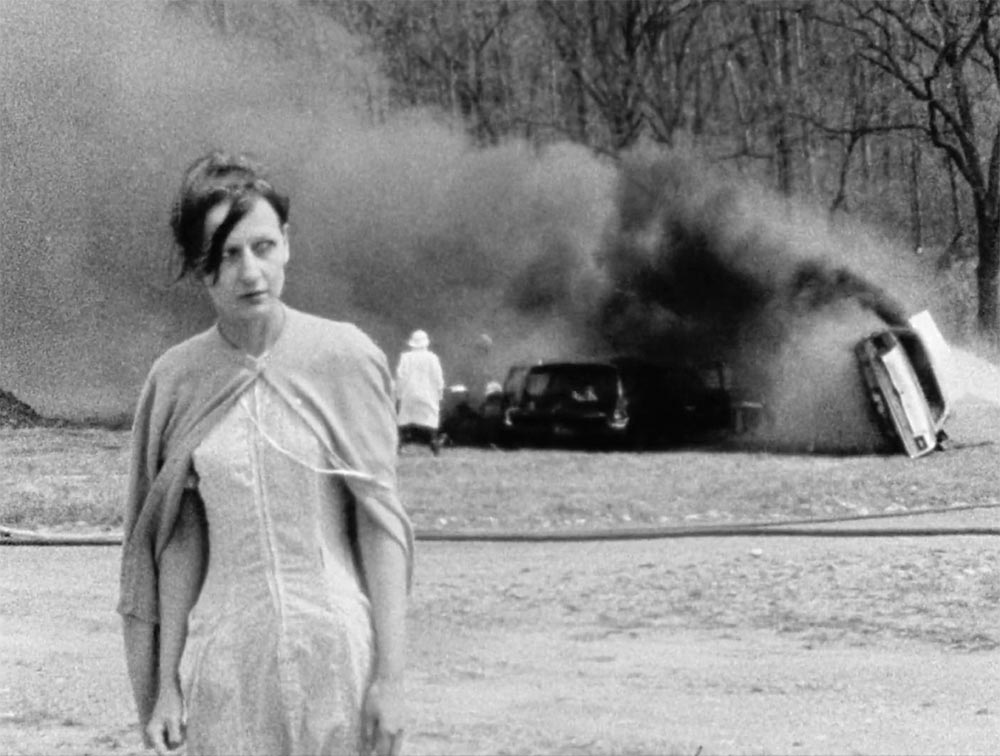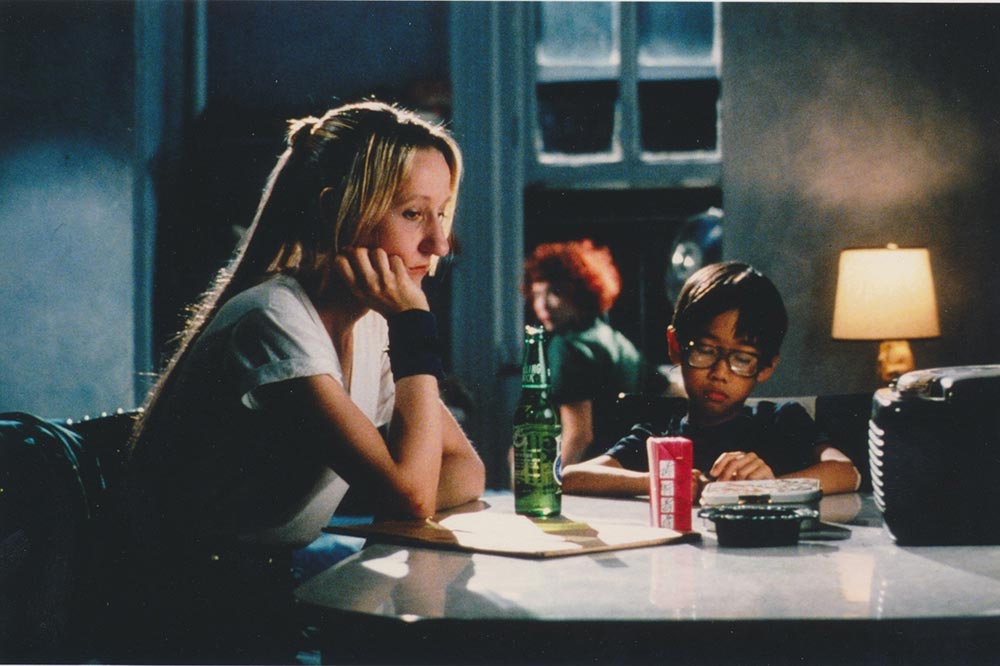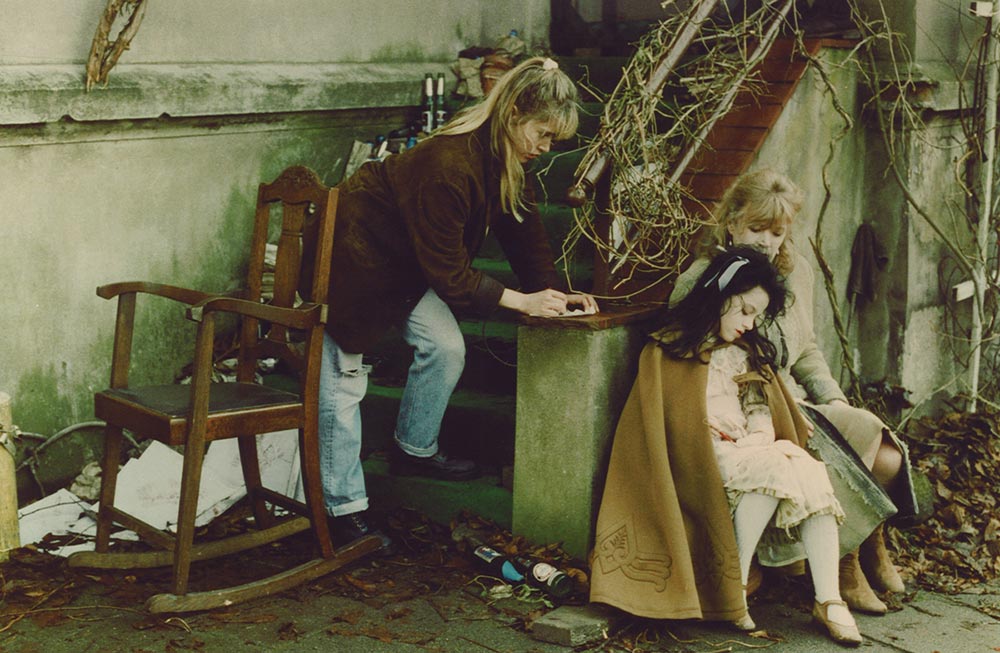In You Are Not I (1981), a wide-eyed, wandering Suzanne Fletcher places rocks in the mouths of the dead bodies she finds lying along the side of a blank exurban road. In Sleepwalk (1986), a slightly less wide-eyed Fletcher moves through an uncanny version of New York at night, living through a Chinese folk tale she’s been hired (by a man missing some fingers, leaving bloody prints on the dollar bills he offers) to transcribe. And When Pigs Fly (1993), shot by the great Robby Müller, uses entirely in-camera effects to populate Alfred Molina’s waking life with a piano-playing woman murdered by her abusive husband.
Sara Driver’s cinematic universe is a living, breathing place, depicting the places we inhabit as they are—haunted by the past, by centuries of myths, and our own personal histories. As Lucy Sante says in Driver’s “videotape,” The Bowery: Spring, 1994 (1994), “the Bowery lives on as a domain of ghosts.”
I talked with Sara in New York on February 1, just before she left for Roxy Cinema to see Claire Denis’s Keep it For Yourself (1991), in which she acted (“last time I saw this was on VHS”) and George Franju’s Judex (1963), which she selected for her retrospective series.
Sierra Pettengill: I am from Long Island. And I never really thought about you coming from New Jersey until I watched all your movies in a row this week. They are so imbued with what it feels like to be from the outskirts of this place.
When I was researching Westfield, NJ, your hometown, I saw on the Wikipedia page that Charles Addams (creator of The Addams Family) was from there.
Sara Driver: I started looking at Charles Addams cartoons before I could read. Everybody in the town had his cartoon books in our houses. This was before the TV show; he started to draw the Addams family in the late ’30s. And we got The New Yorker. He was famous for his New Yorker cartoons.
SP: What a great introduction to the town you live in: through the Charles Addams cartoons!
SD: Charles Addams hung out in the colonial graveyard in Westfield. That was my hangout too. I remember one grave, barely legible, that said, “I told you I was sick.” I think that he had a huge influence on my sensibilities, on my humor.
SP: Can you talk about how you made You Are Not I?
SD: It was very hard to get Paul Bowles’s books at that time. It was the early ’80s. And then his Collected Works came out, put out by Black Sparrow Press. “You Are Not I” is a short story; it is only seven pages long, and it's one of the few that takes place in America. And when I read it I was so shocked by the ending. I remember sitting up in bed, thinking, “What happened?” And then I thought, “I'm going to make a film of this. I'm going to do an exact adaptation of exactly how I felt when I first read the story.” So that's what I tried. That was sort of my guiding light, and to not go too deeply psychological with it.
I did keep Suzanne Fletcher away from the rest of the actors and the crew; she was isolated. And I had Melody Schneider, who played the sister, bring objects that she really liked to the set just to set up a territorial thing. I tried to stay very accurate to the Bowles story.

SP: In watching it, I thought about the experiential realities of addiction, or of grief, or states of shock, and how you don't judge those more subjective states of being, what it feels like to actually be in your body experiencing the world.
It feels like the real violence and trauma of the world is intact, while the fantasy elements, imagination aren’t a way out of that—they’re a way to get closer to it.
How much of our lives do we spend inside of our heads? And yet that world is deemed not real, like it’s not a lived space of equal value…
SD: Right, or like our dreams, right? I remember when Fellini was upset with Roberto Benigni for sleeping 12 hours a day. “Bob, why do you sleep all day long?” And Roberto replied, “When I'm dead, I can't dream.”
SP: Do you write your dreams down?
SD: I have, off and on, over the years. I should get back to it. It always helps my memory muscle with my dreams. But I've gotten so hooked up with the damn computer. And I just go to the computer when I wake up instead of sitting down with a notebook.
I had the weirdest dream the other night where I was tickling an alligator. Under its arms. And it was laughing, and it had a big smile.
SP: I think that is a perfect metaphor for your films! Like going so close to the mouth of the beast and then . . .
SD: . . . giving it a giggle.
SP: I’m thinking of When Pigs Fly. It's so literally haunted by death, and domestic violence, and the real decline of a place where people used to gather. And then it's joyous and funny, and the ghost is running around smashing pots, and Marian Faithfull is singing. That feels like tickling.
SD: That whole production was . . . I wish it was much more tickling of the alligator. It was the alligator eating me. Oh my god. It was a hard film to make.
I shot it in Hamburg and Wismar, a town in former East Germany. And I didn't know when I found a perfect location that Murnau had shot Nosferatu [1922] there, in Wismar. There were Russian soldiers that they couldn't afford to send home, who were marching around the town. They're the extras in the ghost walk scenes.

SP: Speaking of living through history . . . that is crazy.
SD: Then we got hit by the Neo-Nazis. I managed to find one Cadillac to use. And the Neo-Nazis put sugar in the gas tank and painted swastikas on the brick buildings where the bar is, and we couldn’t get that off. And so we had to shoot in another way. And then we hired some of the former Stasi to watch our equipment. There was a lot of hostility between the West and the East. The Fascists burned down the apartments of Vietnamese immigrants in the next town over. The West Germans would say the East Germans were slovenly, and that we couldn't work there because they wouldn't help us. But everyone worked together really well. It was intense.
And then the producers went bankrupt. They wanted me to stay and edit the film there, and I had a feeling something was wrong. So I moved everything out of there and came back to New York to be with my people, and do the post with everybody I knew. I liked a lab in Berlin because I had processed Sleepwalk there. It was cheaper to do prints in Europe, at that time. So, I moved everything from Hamburg to Berlin. The producers never told the bank. So, when the bank called and told me they owned all the negative in Hamburg, I told them they could have it. There was no negative there. The producers were really irresponsible. On the opening credit sequence, I put their credit over dead fish.
SP: That’s incredible.
SD: The only revenge I had.
SP: You gotta take it where you can get it.
SD: But It’s interesting what you said before about using the imagination to fight trauma or darkness. Because that’s what my new film is about.
I wrote it for my best friend, Nicoletta Braschi, who’s a wonderful Italian actress who's been doing Beckett the last ten years. Which doesn't help with film financing. [laughs] She's a great actor.
SP: Did you write it with her?
SD: For 30 years, we've wanted to do something together. And then, when my father was dying, all these ideas that she and I talked about, ideas I'd been thinking about, ideas I had written when I was with her on trips . . . they all just came flooding back, and I wrote the script in five weeks or something. I went into my little shed upstate, and the whole script just came out of me. I don't even know where it came from. I gave it to Jim, and he was dumbfounded that I had written a fully balanced screenplay that needed very little revision. Within just this very intense, limited period.
I think it was working out my feelings about death, you know, because it's about a character who is on her journey to her bigger journey. It’s not sad, it is what it is. And Nicoletta, when she read it— I had it translated into Italian, even though her English is very good. But I didn't want her to have any hiccups when she read it. And her reaction was, “This is Alice in Wonderland at the end of her life.”
My dad had sundowners. It only gets triggered by the changing of the light. Sundowner’s Syndrome causes ocular hallucinations. It happens between the hours of 4 p.m. and 11 p.m., when the light is changing and the shadows come alive.
I love this Cocteau quote, “The cinema is modern writing, so the ink is the light.”
“On the Bowery: Lost and Found Films of Sara Driver” runs through February 8 at Roxy Cinema, with most films running in 35mm. Sierra Pettengill will moderate a Q&A with Driver and actor Eszter Balint after tomorrow night’s screening of Stranger Than Paradise (1984).



